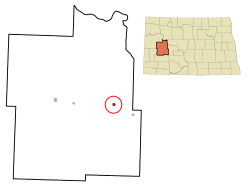Halliday, North Dakota
| Halliday, North Dakota | |
|---|---|
| City | |
 Location of Halliday, North Dakota |
|
| Coordinates: 47°21′12″N 102°20′12″W / 47.35333°N 102.33667°WCoordinates: 47°21′12″N 102°20′12″W / 47.35333°N 102.33667°W | |
| Country | United States |
| State | North Dakota |
| County | Dunn |
| Area | |
| • Total | 0.47 sq mi (1.22 km2) |
| • Land | 0.46 sq mi (1.19 km2) |
| • Water | 0.01 sq mi (0.03 km2) |
| Elevation | 2,047 ft (624 m) |
| Population (2010) | |
| • Total | 188 |
| • Estimate (2014) | 222 |
| • Density | 408.7/sq mi (157.8/km2) |
| Time zone | Mountain (MST) (UTC-7) |
| • Summer (DST) | MDT (UTC-6) |
| ZIP code | 58636 |
| Area code(s) | 701 |
| FIPS code | 38-34340 |
| GNIS feature ID | 1029281 |
| Website | http://www.hallidaynd.com/ |
Halliday is a city in Dunn County, North Dakota, United States. The population was 188 at the 2010 census. Halliday was founded in 1914.
Halliday was originally two miles farther north. It moved in 1914 to be near the new Mandan to Killdeer railroad line. In 1900 the first post office was located on William Halliday's place.
John S. Lesmeister, who served as the 30th North Dakota State Treasurer, grew up in Halliday.
Halliday is located at 47°21′12″N 102°20′12″W / 47.35333°N 102.33667°W (47.353198, -102.336718).
According to the United States Census Bureau, the city has a total area of 0.47 square miles (1.22 km2), of which, 0.46 square miles (1.19 km2) is land and 0.01 square miles (0.03 km2) is water.
As of the census of 2010, there were 188 people, 93 households, and 52 families residing in the city. The population density was 408.7 inhabitants per square mile (157.8/km2). There were 135 housing units at an average density of 293.5 per square mile (113.3/km2). The racial makeup of the city was 90.4% White, 0.5% African American, 5.9% Native American, 1.6% Asian, and 1.6% from two or more races. Hispanic or Latino of any race were 0.5% of the population.
...
Wikipedia
